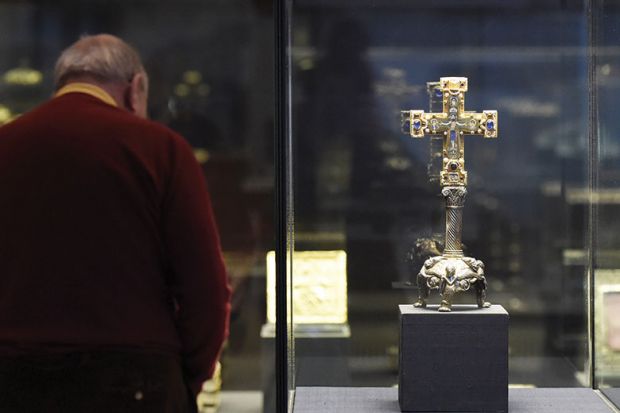Sacred history indicates that Christ ascended bodily into heaven and therefore left few physical remains on earth, apart from his foreskin, which several churches claimed to have. Devotees desired tangible relics. The instruments of the Passion, and the blood associated with them, satisfied such needs, while memorialising the martyr’s pain.
The cross itself paradoxically served as both a reminder of Christ’s execution and a sign of victory over death. From the moment when the Emperor Constantine’s mother Helen first revived a corpse in Jerusalem by exposing it to the True Cross, its blood-stained wood has been considered miracle-working. Alleged fragments of the cross soon flooded the Christian world. The other instruments of the Passion followed suit, with kings, clergy and Crusaders carrying them westward. Anyone who has visited a medieval church treasury in continental Europe will have encountered an enshrined nail or a tiny fragment of the True Cross embedded in a bejewelled golden cross. Visitors to the British Museum can see the dazzling Holy Thorn reliquary, with rubies standing in for Christ’s blood.
Cynthia Hahn tells the story of relics such as these. Her book presents the two Murphy lectures, which she delivered in Kansas in 2014, on “the Power of the Cross” and collections of Passion relics. In arguing that manifestations of Passion relics in the West are “barometers of Christian devotion and its processes”, she discusses their reception, including the imperial use of relics as trophies; the Crusaders’ plundering of relics, which they then scattered throughout the West; and the use of the arma Christi (or instruments of the Passion) as devotional aids. The text makes some useful observations, including that relics were usually packaged in groups. That is the case with those assembled in Paris’ Sainte-Chapelle, built in 1238-48 to house them, and the items deposited by Emperor Charles IV at his castle outside Prague in the 1350s and 1360s, to which Hahn provides useful introductions.
Her book provides an expert synthesis of current scholarship, a welcome introduction for students desiring a toehold in recent literature. In particular, the essays draw on the scholarship of: Holger Klein, who has written about relics and reliquaries in Byzantium and the West; Sible de Blaauw, on the fluidity of function between processional and altar crosses; Glenn Peers, on the relationship between the cross and the body; Elaine Scarry, on tools that inflict pain; and Flora Lewis, who demonstrated relationships between relics and indulgences.
One senses that the opening framing device – a painting by Titian showing the Vendramin family, in various states of awe and rapture, venerating a relic of the True Cross – is itself a relic of the essay’s origins in a performance before an audience that needed a visual aid. Yet readers may baulk at a painting made two centuries after the main body of the book’s evidence being used as an unproblematic document of how Passion relics were venerated in the Middle Ages.
Tradition dictates that major public lectures be published, but perhaps it’s time to rethink this. Bodies of ideas conceived as oral performances, accompanied by a march of visual projections, could retain that form. Recording lectures digitally might be a better way to preserve and disseminate them while capturing their voices for posterity.
Kathryn M. Rudy is professor of art history at the University of St Andrews. Her books include Image, Knife, and Gluepot: Early Assemblage in Manuscript and Print (2019).
Passion Relics and the Medieval Imagination: Art, Architecture, and Society
By Cynthia Hahn
University of California Press, 176pp, £41.00
ISBN 9780520305267
Published 4 February 2020
POSTSCRIPT:
Print headline: All had a piece of the cross to share
Register to continue
Why register?
- Registration is free and only takes a moment
- Once registered, you can read 3 articles a month
- Sign up for our newsletter
Subscribe
Or subscribe for unlimited access to:
- Unlimited access to news, views, insights & reviews
- Digital editions
- Digital access to THE’s university and college rankings analysis
Already registered or a current subscriber? Login







